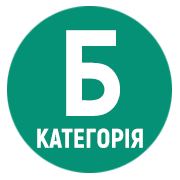ПСИХОЛОГІЧНІ БАР’ЄРИ ТРЕНУВАЛЬНОЇ ТА ЗМАГАЛЬНОЇ ДІЯЛЬНОСТІ СПОРТСМЕНІВ З ХУДОЖНЬОЇ ГІМНАСТИКИ
DOI:
https://doi.org/10.32689/maup.psych.2021.3.7Ключові слова:
психологічний бар’єр, функції і механізми психологічних бар’єрів, психоемоційні станиАнотація
Тренувальна діяльність спортсменів з художньої гімнастики передбачає, окрім фізичної, технічної, тактичної та психологічної підготовки, розвиток психологічної готовності та формування психологічних компетентностей і навичок долати психологічні бар’єри у тренувальній та змагальній діяльності. У статті проаналізовано вирішення проблеми психологічних бар’єрів у зв’язку з актуальністю пошуків шляхів підвищення ефективності спортивної тренувальної діяльності особистості. У контексті проблеми дослідження визначено, що питання психологічних бар’єрів охоплює такі наукові проблеми, як: теоретико-історична ситуація вивчення психологічних бар’єрів у науковій літературі; суб’єктивне сприйняття психологічних бар’єрів; психологічні бар’єри як ресурс мотивації особистісного розвитку. Функціями психологічних бар’єрів визначено: 1) адаптивну; 2) регулятивну, що слугують мотиваторами активності особистості. У психології спорту бар’єри (труднощі, перешкоди) характеризуються через дію зовнішніх факторів – предметних (біг з перешкодами), кліматичних (зустрічний вітер, вологість повітря); та впливу соціально-психологічних чинників – мотивація психомоторної активності в тренувальній діяльності, особистісна психологічна готовність до тренування та участі у змаганнях, володіння прийомами самоорганізації/самомобілізації та стратегіями психоемоційної саморегуляції та ін. Мета статті полягає у теоретичному вивченні психологічних бар’єрів, труднощів у тренувальній та змагальній діяльності спортсменів із художньої гімнастики, аналізі чинників і механізмів їх виникнення. Висновки. Визначено, що поняття «психологічний бар’єр» трактується як психічний стан особистості, що перешкоджає виконанню тих чи інших дій та виявляється в пасивності, апатії, опорі суб’єкта. З’ясовано, що виникнення психологічних бар’єрів у спортсменів зумовлюється: а) дією об’єктивних та суб’єктивних факторів; б) ступенем психологічної готовності до тренувальної та змагальної діяльності; в) особистісними якостями. Психологічні бар’єри у тренувальній та змагальній діяльності спортсменів з художньої гімнастики виникають і формуються як внутрішній опір чи захисні реакції, в основі яких лежить механізм виникнення та утворення умовно-рефлекторних зв’язків психоемоційних реакцій у передбаченні дії суб’єктивних чи об’єктивних подразників (страх втримати предмет, оцінка суддів, реакція тренера, думка глядачів та ін.), які є значущими для гімнастки.
Посилання
Белокопытова Ж.А., Дячук А.М. Факторы, определяющие эффективность начальной подготовки в художественной гимнастике. Физическое воспитание студентов. 2010. № 2. С. 24–28.
Головин С.Ю. Словарь практического психолога. Минск : Харвест, 2001. 592 с. URL: https://elenamatichina.ucoz.net/literatura/slovar_prakticheskogo_psikhologa.pdf.
Костюкевич В.М. Теорія і методика спортивної підготовки (на прикладі командних ігрових видів спорту) : навчальний посібник. Вінниця : Планер, 2014, 616 с.
Массанов А.В. Психологічні бар’єри в професійному самовизначенні особистості : дис. … докт. психол. наук : 19.00.07. Одеса, 2010. 409 с.
Массанов А.В. Психологічні бар’єри в діяльності людини. URL: https://scienceandeducation.pdpu.edu.ua/doc/2009/4_2009/5.pdf.pdf.
Немов Р.С. Психология : учебник для студентов высших педагогических учебных заведений. Москва : Гуманит. изд. центр ВЛАДОС, 2003. 688 с.
Нестерова Т.В. Структура многолетней подготовки спортсменок на уровне достижений в художественной гимнастике. Современный олимпийский спорт и спорт для всех. 2007. С. 182–185.
Полілуєва І.В. Особливості емоційно-вольової регуляції спортивно-художньої діяльності у підлітковому віці : дис. … канд. психол. наук : 19.00.07. Харків, 2018. 235 с.
Петровский А.В., Ярошевский М.Г. Психологический словарь. Москва : Политиздат, 1990. 449 с.
Сосина В.Ю. Хореография в гимнастике. Киев : Олимпийская литература, 2009. 146 с.
Топол Г.А. Комплексна оцінка підготовленості кваліфікованих спортсменок у художній гімнастиці : дис. … канд. наук з фізичного виховання і спорту : 24.00.01. Київ, 2017. 217 с.
Kozina Z., Chaika O., Safronov D., Prokopenko I., Kozin S., Shkrebtii Y., Trubchaninov M., Falyova O. Biomechanical Running Indicators and Neurodynamic Functions of an Elite Athlete with Visual Impairment in a Track and Field Sprint. International Journal of Applied Exercise Physiology. 2019. Vol. 8. P. 10–25.





